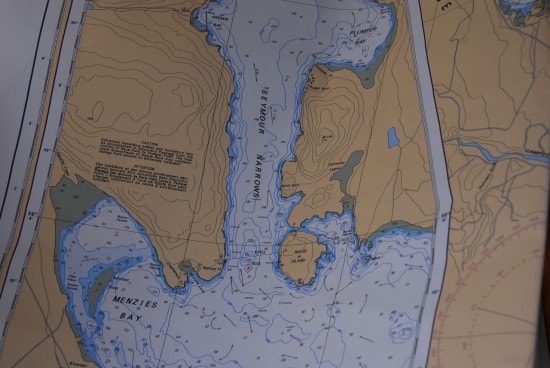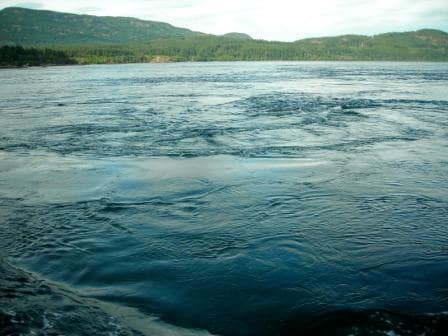Today is the last day of the cruise and the weather forecast responded to the requirements of the sightseeing schedule. The moment the ship entered the Inside passage near Pine Island (that is close to the NW point of Vancouver Island) the sun came out and stayed out until sun set. That meant that the ship went through Seymour’s Narrows in full daylight with the sun shining on the Eastern Bank and that is the Mainland side. It is not often that you get a view that good and I almost thought: for this we could charge a lot of money. Luckily the guests appreciated it all and every window seat was occupied with happy guests gazing at the Canadian Inside Passage at its best.
The ship went in with the following tide and that meant that the ship was “flushed” through the three narrow passages along the route, Blackney Passage, Race Passage and Seymour Narrows itself. On average there was 4 knots of current running with the ship in some areas. When you have four knots it does not mean that the ship goes 4 knots faster. It all depends how much grip the water has on the hull of the ship and that depends again on the fact of how wide the passage is. Yes in Blackney Passage there was 4 knots but as soon as the ship was out of it and entered Johnstone Strait which is much wider, it dropped down again to a knot or so. Still it helps with reducing the fuel consumption and if the ship is able to sail with one engine less for a day, then that means $ 12,000 saved.
The Volendam has 5 motor engines, all 12 cylinders which produce just short of 60,000 HP. Most of that power goes to two Electric motors and that gives the ship a speed of 24 knots maximum. But then everything that is available in power is directed to the Electric motors. Normal maximum cruising speed is about 22 knots and that leaves then enough power for running the whole hotel operation. When the first ship, the Statendam came out in 1992 with this diesel – electric configuration, the crew tried to let the engine – configuration run by itself as that was the way the ship was designed. However it was soon found out that if usage went up just one Watt over the maximum, automatically another engine would start. So the cook switching on his grill would cause another engine to come on line. Not very fuel sufficient. Plan A was that when the kitchen started working, the bridge took a little bit back in speed (read power consumption) and when the kitchen was completely on line, tried to nudge back up again to maximum output on the same engine configuration. That output was mostly around 86%, on whatever engine configuration that was in use.
But fuel got more expensive and then it was figured out that the most economical speed for our Sulzer diesel engines as 70%. We have fuel curves from various tests that show that output/versus fuel is at its best around that percentage. Since that time we do not have to worry anymore about the kitchen as now the startup limit for the next engine lays far above that 70%. Still it was funny to see the Officer of the Watch take speed/power back in the morning, to anticipate the cooks starting up all the galley equipment at the same time. You could plan for that as shipboard routine is nearly always the same. In the same way that the OOW starts to recognize standard fire alarms. At 06.30 hrs. you can expect a fire alarm as that is the moment, the bread toaster in the crew mess is switched on and while it is heating up it burns off the residual of the night before.
So we sailed through Seymour Narrows, just before slack tide. The B.C pilots are normally comfortable with a window of 3 knots flood to – slack – to 3 knots ebb. Slack is the easiest time to go through as with zero knots current you have the most time to make the zig zag course in the fairway. Although the current is zero, it does not mean that the water is quiet. There is still turmoil in the form of eddies, as the current is changing and it does not change everywhere at the same time. When you go through such an Eddy, it is strong enough to make the ship list. The more current there is, the less eddies as the water is now flushing straight through. As a result the pilots are forever having arguments among themselves about what the optimum moment is for going through. I normally put the stabilizers out and that takes care of any wobble that those eddies might cause.
Tomorrow we are in Vancouver and it promises to be a great day if a bit breezy. Temperatures up to 25oC are expected, so the guests on this cruise should be very grateful for the great cruise that they have had.



July 3, 2014 at 12:54 am
Captain Albert, a few months ago several of us reported that we no longer received the email notification when a new blog entry was posted. You said it was being worked on. Is there any progress to report? The system says I am subscribed but I don’t receive those notifications. I just realized there is a whole week of blogs to read. It would be very helpful to get those email notifications again. Thank you.
July 4, 2014 at 10:40 pm
Well
I have to say sorry,they keep promising a solution.
IT is looking into it and hopefully it will be resolved.
In the mean time, than you for reading my blog and lets hope it gets fixed quickly
Captain Albert
July 15, 2014 at 11:23 am
Same issue here and I finally signed up with a new email. Figured it was a loosing battle so why not make the software program happy and be someone new!